This article needs additional citations for verification .(March 2024) |
This is a list of flags of Brussels, including symbolic regional and sub-regional flags, standards and banners used exclusively in Brussels.
This article needs additional citations for verification .(March 2024) |
This is a list of flags of Brussels, including symbolic regional and sub-regional flags, standards and banners used exclusively in Brussels.
| Flag | Date | Use | Description | Note |
|---|---|---|---|---|
 | 9 January 2015–Present | Flag of the Brussels-Capital Region | Stylized yellow, grey and white iris on a blue background | [1] [2] |
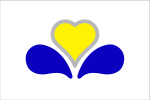 | Stylized yellow, grey and blue iris on a white background.à | |||
 | Stylized blue, grey and white iris on a yellow background. | |||
 | Stylized yellow, blue and white iris on a grey background. | |||
 | Stylized black and white iris on a white background. | |||
 | Stylized black and white iris on a black background. |
| Flag | Date | Use | Description | Note |
|---|---|---|---|---|
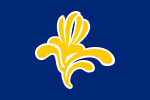 | Flag of the Common Community Commission | A white bordered yellow iris on a blue background. | ||
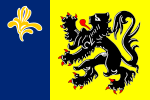 | 1992–Present | Flag of the Flemish Community Commission | A black lion, red clawed and tongued on a yellow background, with a blue vertical stripe along the brocade with a yellow iris with a white border in the brocade top. The flag of the Flemish Community Commission is based on the former flag of the Brussels-Capital Region and the flag of Flanders. | [3] |
 | Flag of the French Community Commission | Quartered 1. and 4. yellow with a red cock 2. and 3. blue with a yellow iris with a white border. The flag of the Flemish Community Commission is based on the former flag of the Brussels-Capital Region and the flag of Wallonia. | [3] |
| Flag | Date | Use | Description | Note |
|---|---|---|---|---|
 | Flag of the Municipality of Anderlecht | Two equally long strips of blue and yellow. | [4] | |
 | 6 January 1925–Present | Flag of the Municipality of Auderghem | Divided into three fields, blue (upper left half), green (lower left half) and red (right half). | [5] |
 | 18 December 2008–Present | Flag of the Municipality of Berchem-Sainte-Agathe | Quartered of white and green. | [6] |
 | 1930s–Present | Flag of the City of Brussels | Two equally long strips of green and red with a yellow St Michael's at the centre. | [7] |
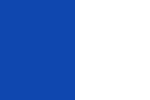 | Flag of the Municipality of Etterbeek | Two equally long strips of blue and white. | [8] | |
 | Flag of the Municipality of Evere | Right beveled in four lanes of white and green. | [9] | |
 | Flag of the Municipality of Forest | Two equally long strips of green and white. | [10] | |
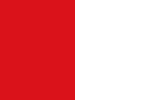 | Flag of the Municipality of Ganshoren | Two equally long strips of red and white. | [11] | |
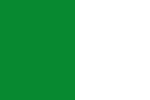 | Flag of the Municipality of Ixelles | Two equally long strips of green and white. | [12] | |
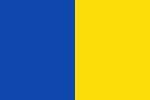 | Flag of the Municipality of Jette | Two equally long strips of blue and yellow. | [13] | |
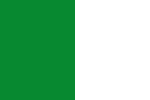 | 1984–1995, ?–Present | Flag of the Municipality of Koekelberg | Two equally long strips of green and white. | [14] |
 | Flag of the Municipality of Molenbeek-Saint-Jean | Two equally long strips of blue and yellow. | [15] | |
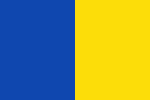 | Flag of the Municipality of Saint-Gilles | Two equally long strips of blue and yellow. | [16] | |
 | Flag of the Municipality of Saint-Josse-ten-Noode | Two equally long strips of blue and red. | [17] | |
 | Flag of the Municipality of Schaerbeek | Two equally long strips of green and white. | [18] [19] | |
 | Flag of the Municipality of Uccle | Two equally long strips of blue and white. | [20] | |
 | Flag of the Municipality of Watermael-Boitsfort | Two equally long strips of blue and white. | [21] | |
 | Flag of the Municipality of Woluwe-Saint-Lambert | Two equally long strips of black and of white. | [22] | |
 | Flag of the Municipality of Woluwe-Saint-Pierre | Two equally long strips of green and white. | [23] |
| Flag | Date | Use | Description | Note |
|---|---|---|---|---|
 | Flag of the Université Libre de Bruxelles | Seal of the ULB on a white background. | [7] | |
 | 19 March 1970 – Present | Flag of the Vrije Universiteit Brussel | Coat of arms of the VUB on a white background. | [24] |
| Flag | Date | Use | Description | Note |
|---|---|---|---|---|
 | 16 May 1991 – 9 January 2015 | Flag of the Brussels-Capital Region | A white bordered yellow iris on a blue background. | [25] [26] |
| Flag | Date | Use | Description | |
|---|---|---|---|---|
 | 1900s | Flag of the City of Brussels | Two equally long strips of green and red. | [7] |
 | 1900s | Two equally long strips of green and red. | [7] | |
 | 1930s | A green border on a red background. | [7] | |
 | 1841–1984 | Flag of the Municipality of Koekelberg | Two equally long strips of green and pink. | [14] |
 | 1995–? | [14] | ||
 | ?–30 March 1921 | Flag of the Municipality of Laeken | A yellow field with two stripes in blue. |

Berchem-Sainte-Agathe or Sint-Agatha-Berchem, often simply called Berchem, is one of the 19 municipalities of the Brussels-Capital Region, Belgium. Located in the north-western part of the region, it is bordered by Ganshoren, Koekelberg, and Molenbeek-Saint-Jean, as well as the Flemish municipalities of Asse and Dilbeek. In common with all of Brussels' municipalities, it is legally bilingual (French–Dutch).

Saint-Josse-ten-Noode or Sint-Joost-ten-Node, often simply called Saint-Josse in French or Sint-Joost in Dutch, is one of the 19 municipalities of the Brussels-Capital Region, Belgium. Located in the north-eastern part of the region, it is bordered by the City of Brussels and Schaerbeek.
Articles related to Belgium include:

Schaerbeek or Schaarbeek is one of the 19 municipalities of the Brussels-Capital Region, Belgium. Located in the north-eastern part of the region, it is bordered by the City of Brussels, Etterbeek, Evere and Saint-Josse-ten-Noode. In common with all of Brussels' municipalities, it is legally bilingual (French–Dutch).

Brussels-Halle-Vilvoorde is a judicial arrondissement encompassing the bilingual—French and Dutch—Brussels-Capital Region, which coincides with the administrative arrondissement of Brussels-Capital and the surrounding Dutch-speaking area of Halle-Vilvoorde, which in turn coincides with the administrative arrondissement of Halle-Vilvoorde. Halle-Vilvoorde contains several municipalities with language facilities, i.e. municipalities where French-speaking people form a considerable part of the population and therefore have special language rights. The arrondissment is the location of a tribunal of first instance, enterprise tribunal and a labour tribunal.

The Maelbeek or Maalbeek is a stream that runs through several municipalities in Brussels, Belgium, including Etterbeek, Ixelles, Saint-Josse-ten-Noode, Schaerbeek. It is a tributary of the Senne, which it joins up in Schaerbeek, from its source located to the south near La Cambre Abbey. Maelbeek/Maalbeek metro station is located in the central area of this Maalbeek valley.

Laeken Cemetery in Brussels, Belgium, is the city's oldest cemetery still in function and the resting place of the Belgian royal family. It is known as the Belgian Père Lachaise, after Paris' famous cemetery, because it is the burial place of the rich and the famous and for the abundance of its funerary heritage.
In Belgium, there are judicial and electoral cantons.

Brussels-North railway station is one of the three major railway stations in Brussels, Belgium; the other two are Brussels-Central and Brussels-South. Every regular domestic and international train passing there has a planned stop. The station has 200,000 passengers per week, mainly commuters, making it one of the busiest in Belgium.
The N2 road in Belgium is a road connecting Brussels and Maastricht passing Leuven, Diest and Hasselt. It starts in Brussels at the Madou crossroad on the small ring, heading northeast as the Chaussée de Louvain/Leuvensesteenweg, which crosses the municipalities of Saint-Josse-ten-Noode, City of Brussels, Schaerbeek, Evere and Woluwe-Saint-Lambert in Brussels, and then enter Flanders via the municipality of Zaventem, Flemish Brabant.

The tram route 82 in Brussels, Belgium, is a tram route operated by STIB/MIVB, which connects Berchem-Sainte-Agathe railway station in Berchem-Sainte-Agathe to Drogenbos Castle in the Flemish municipality of Drogenbos. After 8 p.m., the route terminates at Brussels-South railway station, with connections to Drogenbos provided by tram route 32.

Schaerbeek Cemetery, officially Schaerbeek New Cemetery, is a cemetery belonging to Schaerbeek in Brussels, Belgium, where the municipality's inhabitants have the right to be buried. It is not located in Schaerbeek itself; rather it is partially in the neighbouring municipality of Evere, and partially in the village of Sint-Stevens-Woluwe in Zaventem, Flemish Brabant. The cemetery is adjacent to Brussels Cemetery and Evere Cemetery, but should not be confused with either.

Saint-Josse-ten-Noode Cemetery is a cemetery belonging to Saint-Josse-ten-Noode in Brussels, Belgium, where the municipality's inhabitants have the right to be buried. It is not located in Saint-Josse itself, but in the neighbouring municipality of Schaerbeek.
Karacalar is a village in the Emirdağ District, Afyonkarahisar Province, Turkey. Its population is 667 (2021).

Saint Mary's Royal Church is a Catholic parish church located on the Place de la Reine/Koninginneplein in the Brussels municipality of Schaerbeek, Belgium. Officially dedicated to Our Lady of the Assumption, it is popularly associated with Queen Louise-Marie, first Queen of the Belgians, as is the square where it is located, which earned it the title of "Royal".

The Art Deco movement of architecture and design appeared in Brussels, Belgium, immediately after World War I when the famed architect Victor Horta began designing the Centre for Fine Arts, and continued until the beginning of World War II in 1939. It took its name from the International Exposition of Modern Decorative and Industrial Arts held in Paris in 1925. At the end of World War II, Art Deco in Brussels faded to make way for the modernist and international architectural styles that would mark the postwar period.
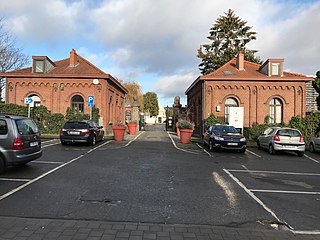
Molenbeek-Saint-Jean Cemetery is a cemetery belonging to Molenbeek-Saint-Jean in Brussels, Belgium, where the municipality's inhabitants have the right to be buried. It is located at 539, Chaussée de Gand/Gentsesteenweg, in the west of the municipality. The ensemble extends over 1.5 hectares.
{{cite web}}: Missing or empty |title= (help)